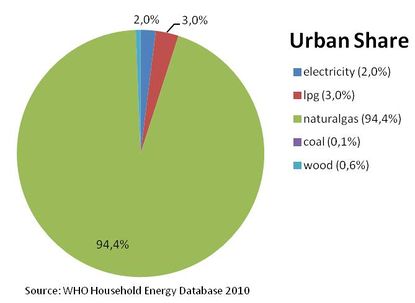Uzbekistan Energy Situation
Overview
| Uzbekistan | |||
| 500px-Flag of Uzbekistan svg.png |
Uzbekistan focused.png | ||
|
Capital |
Tashkent [1] | ||
|
Official Language(s) |
Uzbek; Karakalpak | ||
|
Government |
Presidential Republik | ||
|
President |
Islam Karimov | ||
|
Prime Minister |
Shavkat Mirziyoyev | ||
|
Total area in km2 |
447,400 | ||
|
Population |
28,128,600 [2] | ||
|
Rural Population |
17,721,018 | ||
|
Urban Population |
10,407,582 | ||
|
Population Density per km² |
61.4 | ||
|
GDP (nominal)(million $US) |
25712.00 | ||
|
GDP per Capita (US$) |
945.60 | ||
|
GNI per Capita (US$): |
948.30 | ||
|
Currency |
Uzbekistan som (O'zbekiston so'mi) (UZS)[3]
| ||
|
Time Zone |
UZT (UTC +5) | ||
|
Calling Code |
+998 | ||
Environmental Situation
Climate
Mean temperature (°C min/max): 8.3/21.0 [4]
Resources
Natural gas, petroleum, coal
Forest situation
Land Area Covered by Forest : 8.0%
Forest Annual Rate of Change : -0.12% (2005-2010)[5]
Socioeconomical Situation
Income Sources
Agriculture: 44%, industry: 20%, services: 36% [6]
Energy Situation
Uzbekistan is the second largest of the Caspian gas producers, after Turkmenistan. Its abundant natural gas resources are used both for domestic consumption and export. [7]
Energy Supply
Type your text here
Electricity
Sources
Hydropower: 11.8%; Fossil fuel: 88.2% [8]
Stability
Type your text here
Energy Consumption
Type your text here
National Level
Electricity
Household Level
Fuel wood in the arid zones of Uzbekistan is often scarce as a result of deforestation and range degradation. Phasing out of energy subsidies has caused that livestock manure is used for heating and cooking, because alternative energy sources are no longer available or affordable. The country has used livestock manure in many traditional practices such as aerobic digestion (composting), anaerobic digestion (biodigesters), and as a direct application as organic fertilizer. [9]
Type your text here
Access Rate
Electrification Rate
National: 94.4%
Renewable Energies
Application
Type your text here
Potentials
Solar Energy
Type your text here
Wind Energy
Type your text here
Biomass
Type your text here
Biogas
Type your text here
Hydro Power
Type your text here
Other renewable Sources
Type your text here
Key problems of the energy sector
Type your text here
Policy framework, laws and regulations
Type your text here
General Energy policy, Energy strategy
A National EE Strategy has been in place since 2001. Besides international initiatives a campaign has been carried out to install meters for consumers of natural gas and hot water. As a result, energy intensity of GDP decreased by 10%, from 0.96 kgoe/$ in 2000 to 0.86 kgoe/$ in 2004, still considerably high levels. There is also an Energy Efficiency Programme for the period to 2010, targeting 50% energy savings in the household and utility sectors. [10]
Important Laws and regulations
Type your text here
Specific strategies (Biomass, renewable energies, rural electrification, energy access strategy etc.)
Type your text here
Institutional set up in the energy sector
Type your text here
Governmental institutions Private sector (enterprises, NGOs)
Type your text here
Activities of other donors, activities of NGOs
Type your text here
Existing projects
Type your text here
Publications
Type your text here
External links
References
- ↑ www.Wikipedia.org
- ↑ CIA - The World Factbook
- ↑ www.Wikipedia.org
- ↑ CIA - The World Factbook
- ↑ FAO (2011): The State of the World's Forest
- ↑ CIA - The World Factbook
- ↑ IEA (2009): World Energy Outlook.
- ↑ IEA (2009): World Energy Outlook.
- ↑ Toerich K., et. al. (2008): Utilization of Agriculture Residues and Livestock wast in Uzbekistan
- ↑ INOGATE - Energy Portal: http://www.inogate.org/





















